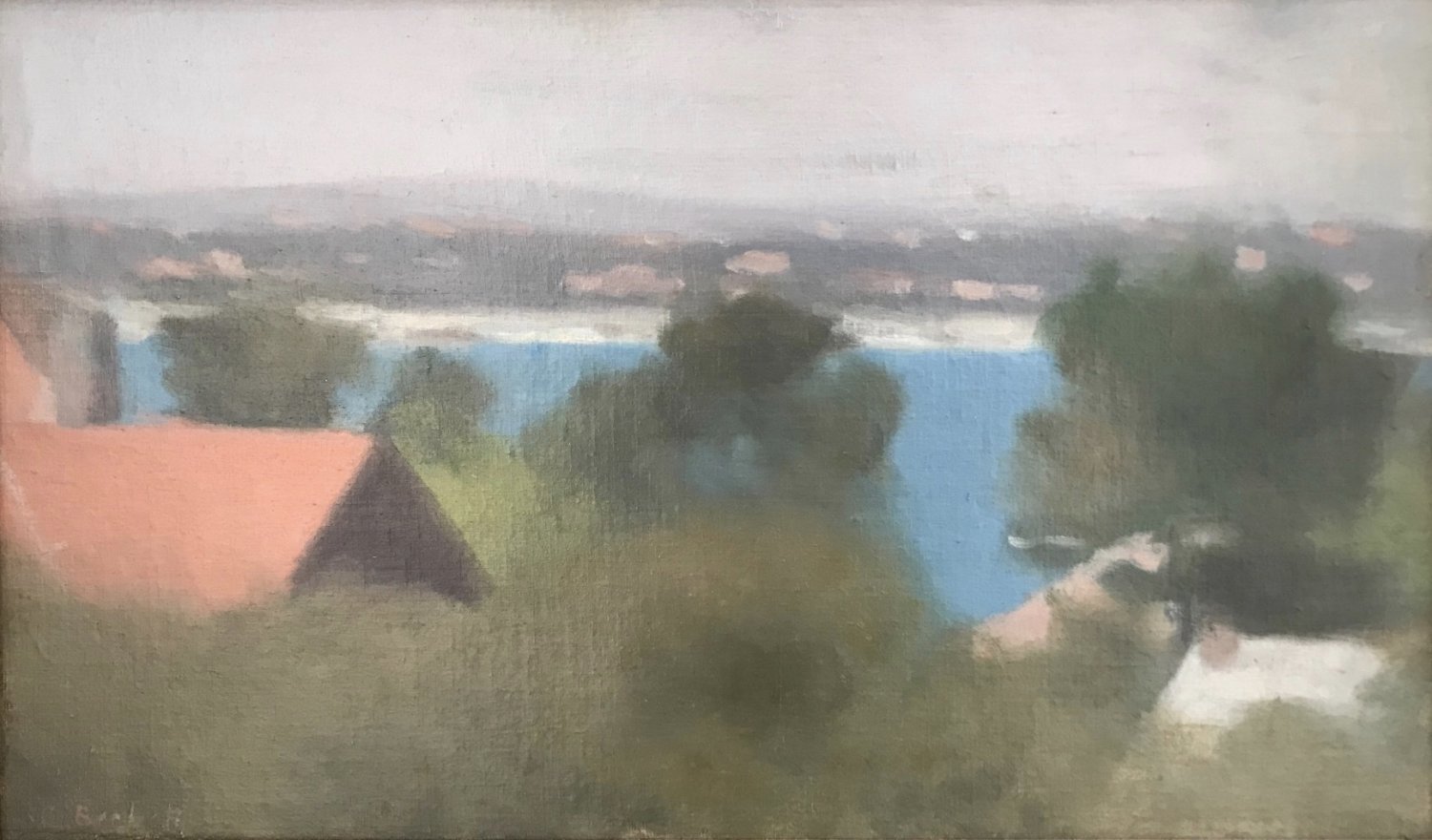Clarice Beckett
Beaumaris, c.1932
oil on artist board
28.5 x 48.5 cm
signed ‘C Beckett’ (lower left)
SOLD
Provenance
Sotheby's, Sydney, 23 May 1999, Lot No. 598
Private collection, Sydney
Clarice Beckett, against all odds, has become recognised as one of Australia’s major modernist painters. Maligned by the art establishment during her life, she was almost anonymous until the 1970s, when a resurgent interest in her paintings finally brought the recognition she deserved.
Beaumaris is a late landscape depicting the Melbourne bay that Beckett had visited since childhood. It features two of her common motifs: the sea, painted in a rich but dry blue; and the roof of a house, its orange tiles melded into a flat block. These passages of colour, along with the warm yellows and cool greens of the foreground foliage, fade into her characteristic gray, atmospheric haze. A comparable landscape painted from the same perspective, (Across the Bay), 1932, was included in the 1999-2000, touring retrospective, Politically Incorrect: Clarice Beckett, curated by the Ian Potter Museum of Art at the University of Melbourne.

Clarice Beckett, against all odds, is now recognised as one of Australia’s major modernist painters. Maligned by the art establishment during her life, she was close to anonymous until the 1970s, when a resurgent interest in her works finally brought the recognition she deserved.
Born in rural Victoria in 1887, Beckett took charcoal drawing lessons as a child before enrolling in the National Gallery School in Melbourne under Frederick McCubbin. She was an early leaver of the school before the defection of Arnold Shore, Colin Colahan and others, all of whom went to learn under the tutelage of the controversial Australian Tonalist artist Max Meldrum. While Meldrum once famously deemed that “There would never be a great woman artist and there never had been”, he came to see Beckett as his star pupil. “She worked like a man”, he said in a patronising compromise. (Quoted in Rosalind Hollinrake, Clarice Beckett: Politically Incorrect, The Ian Potter Museum of Art, University of Melbourne, 1999, p. 15.)
Tonalism – with its hazy edges, pastel palette and minimal subjects – flew in the face of the predominant Heidelberg School vision of bold colours in narrative paintings. Beckett’s distinctive “blur” gave an atmosphere to all her landscapes and still lifes, recalling Whistler’s belief that paint should be “like breath on the surface of a pane of glass”. (Tracey Lock, The present moment: The art of Clarice Beckett, Art Gallery of South Australia, 2021, pp. 102-104.)
In 1924, Beckett provided a simple artist statement to explain her artistic objectives: “To give a sincere and truthful representation of a portion of the beauty of Nature, and to show the charm of light and shade, which I try and set forth in correct tones so as to give nearly as possible an exact illusion of reality." (Clarice Beckett, 20 Melbourne painters, 6th Annual Exhibition Catalogue, 1924.)
It was while painting one of her many seascapes that she caught pneumonia in 1935 and died, aged just 48. A shed containing nearly 2000 of her paintings was left abandoned, exposed to the elements. By the time they were found over thirty years later, over 1000 of them had been irreparably damaged.
Her resurgence in the art world began in the 1970s upon the discovery of this large cache of works and a 1971 exhibition curated by Rosalind Hollinrake in Melbourne. Since then, she has received a number of major exhibitions, including Clarice Beckett: Politically Incorrect, Ian Potter Museum of Art, University of Melbourne, Melbourne (1999); and most recently Clarice Beckett: The present moment, Art Gallery of South Australia, Adelaide (2021). Her work is now held in all major public collections in Australia.